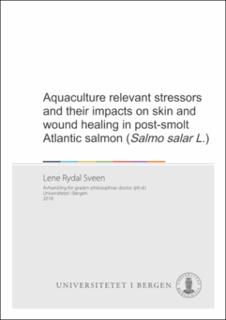Aquaculture relevant stressors and their impacts on skin and wound healing in post-smolt Atlantic salmon (Salmo salar L.)
Doctoral thesis
Permanent lenke
https://hdl.handle.net/1956/19024Utgivelsesdato
2018-11-30Metadata
Vis full innførselSamlinger
Sammendrag
The work described in this thesis focuses on the response mechanisms in the skin of post-smolt Atlantic salmon (Salmo salar L.) under the following challenging conditions: <ul> i. The effect of high biomass and low specific water flow on skin integrity (paper I) ii. The effect of high biomass followed by acute challenge test on mucin transcription in skin (paper II) iii. General wound healing mechanisms in Atlantic salmon skin (paper III) and the effect of high biomass on wound healing (paper IV) iv. The effect of handling stress on mucin transcription (paper II) </ul> High biomass is predicted to provide greater profitability in the production of fish in closed systems. Similarly, low water flow can reduce costs associated with water treatment and water supply. In paper I, these hypotheses were challenged. Five fish densities (25, 50, 75, 100 and 125 kg/m3) and four levels of specific water flow (0.2, 0.3, 0.4 and 0.5 l /kg fish/min) were established to detect effects on salmon skin. After eight weeks, both high biomass (≥ 100 kg/m3) and low specific water flow, (0.2-0.3 l /kg/min) led to activated stress and immune responses in the skin of post-smolt, including increased transcription of mucin-like genes. The main constituency of the mucus layer are big gel-forming proteins called mucins. In paper II, seven gel-forming mucins, including two mucin2 and five mucin5 variants, were identified based on a computational pipeline consisting of annotation, transcription, domain structure and phylogenetic analysis. Mucin2 was predominantly expressed in the intestine, while the mucin5 family was expressed in many organs, including skin and gills. In order to investigate transcriptional regulation of mucins during stress conditions, two controlled experiments were conducted. In the first experiment, handling stress induced mucin transcription in the gill, while transcription decreased in the skin and intestine. In the second experiment, long term intensive rearing conditions interrupted by additional acute challenge test led to increased transcription of mucin genes in the skin at one, seven and fourteen days post-challenge. Farmed fish are particularly vulnerable to skin damage which may occur after handling, confinement, infections and more. The same procedures may trigger stress responses in the fish. Thus, the goal of paper III was to describe the general cutaneous wound healing mechanisms in post-smolts while paper IV focused on the effects of chronic stress on wound healing. Two experimental groups were created where low fish density was used as control (x̄ = 14 kg/m3) and high fish density (x̄ = 126 kg/m3) as chronic stress factor. Deep cutaneous wounds were inflicted on the flank of the fish by using a 5mm punch biopsy tool and the following healing process was documented with seven sampling points over a period of 53 days. The results showed that the healing process was dominated by an early acute inflammatory phase and a later regenerative stage with connective tissue formation and wound contraction. Both the histological analyses and the transcriptional responses fully supported these findings. Stress changed several steps in the healing process, including re-epithelialization, the mucus response, scale mineralization, pigmentation, formation of fibrous tissue and wound contraction, as demonstrated by histology and picture analysis. The transcriptional analyses showed that the inflammatory response was enhanced by chronic stress, while several genes involved in tissue repair were downregulated. These alterations may be used as key check points in future studies when evaluating the effect of a given treatment on cutaneous wound healing. In conclusion, the challenging conditions applied in this thesis in general enhanced the inflammatory reactions or altered the mucus response in the skin of post-smolt Atlantic salmon. Molecular analyses on intact skin and wound samples can thus be used to detect adverse effects of the aquatic rearing environment, including effects that cannot be detected by traditional welfare analyses.
Består av
Paper I: Lene Rydal Sveen, Gerrit Timmerhaus, Jacob Seilø Torgersen, Elisabeth Ytteborg, Sven Martin Jørgensen, Sigurd Handeland, Sigurd O. Stefansson, Tom Ole Nilsen, Sara Calabrese, Lars Ebbesson, Bendik Fyhn Terjesen, Harald Takle. Impact of fish density and specific water flow on skin properties in Atlantic salmon (Salmo salar L.) post-smolts. Aquaculture 464 (2016) 629–637. The article is available in the main thesis. The article is also available at: https://doi.org/10.1016/j.aquaculture.2016.08.012Paper II: Lene Rydal Sveen, Fabian Thomas Grammes, Elisabeth Ytteborg, Harald Takle, Sven Martin Jørgensen. Genome-wide analysis of Atlantic salmon (Salmo salar) mucin genes and their role as biomarkers. PLoS ONE 12(12): e0189103. The article is available at: http://hdl.handle.net/1956/19022
Paper III: Lene Rydal Sveen, Gerrit Timmerhaus, Aleksei Krasnov, Harald Takle, Sigurd O. Handeland, Elisabeth Ytteborg. Wound healing in post-smolt Atlantic salmon (Salmo salar). Scientific Reports 9: 3565. The article is available at: http://hdl.handle.net/1956/19267
Paper IV: Lene Rydal Sveen, Gerrit Timmerhaus, Aleksei Krasnov, Harald Takle, Sigurd O. Handeland, Sigurd O. Stefansson, Elisabeth Ytteborg. Chronic stress delays wound healing in Atlantic salmon (Salmo salar). Published as: High fish density delays wound healing in Atlantic salmon (Salmo salar). Scientific Reports 8: 16907. The article is available at: http://hdl.handle.net/1956/19023
